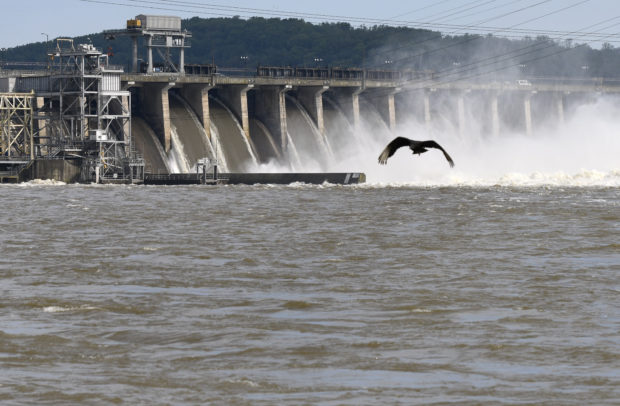Experts warn of climate change’s impact on Chesapeake Bay
CONOWINGO, Md. – When the Conowingo Dam opened to fanfare nearly a century ago, the massive wall of concrete and steel began its job of harnessing water power in northern Maryland.

Water flows through Conowingo Dam, a hydroelectric dam spanning the lower Susquehanna River near Conowingo, Md., on Thursday, May 16, 2019. Officials once counted on the dam to block large amounts of sediment in the Susquehanna from reaching Chesapeake Bay, the nation’s largest estuary, but the reservoir behind the dam has filled with sediment far sooner than expected. (AP Photo/Steve Ruark)
It also quietly provided a side benefit: trapping sediment and silt before it could flow miles downstream and pollute the Chesapeake Bay, the nation’s largest estuary.
The old hydroelectric dam spanning the lower Susquehanna River is still producing power, but its days of effectively trapping sediment in a 14-mile (22.5-kilometer) long reservoir behind its walls are over.
Behind the 94-foot (29-meter) high barrier lies a massive inventory of coal-black muck — some 200 million tons (181 million metric tons) of pollutants picked up over decades from farmlands, industrial zones and towns.
How big a threat this sediment stockpile poses to the Chesapeake Bay or whether anything can even be done about it depends on who one talks to.
With Maryland pushing to curb pollution in dam discharges, the issue has become a political football as Conowingo’s operator seeks to renew its federal license to operate the dam for 46 more years after its old license expired.
Article continues after this advertisementAnd as negotiations drag on, the lack of agreement about curbing runoff pollutants following the wettest year on record imperils hard-won gains in restoring the Chesapeake Bay.
Article continues after this advertisementThe iconic estuary famed for its blue crabs and oysters has been gradually rebounding under a federal cleanup program launched in 1983 that put an end to unbridled pollution.
But the 200-mile (325-kilometer) long bay is increasingly being ravaged by runoff-triggering downpours, including record-setting rainfall in 2018 and this year’s soggy spring.
Intense cycles of downpours are washing pollutants into the Chesapeake from municipal sewer overflows, subdivisions and farms where manure often isn’t effectively handled and nitrogen and phosphorous-rich fertilizers are used.
Experts say climate change is accelerating the environmental decline, potentially leading to more damaging algae blooms and dead zones in the Chesapeake and coastal waters.
Maryland politicians and watermen who make their living off the bay’s fragile bounty portray the sediment stored behind the Conowingo as an existential threat, asserting the massive deposit of reservoir muck would devastate the bay if ever released downstream in a major storm.
They note that sediment freely flows over the dam during downpours, turning the upper bay’s waters a murky brown.
“The situation behind the dam is a ticking time bomb,” said Genevieve Croker, spokeswoman for the Clean Chesapeake Coalition, a grouping of rural Maryland counties that have Republican Gov. Larry Hogan’s ear.
Qian Zhang, an assistant research scientist at the University of Maryland Center for Environmental Science, confirms that the sediment does flow freely.
“The reservoir is no longer capable of trapping sediment and sediment-associated nutrients. It will release sediment during storm events, creating room for sediment to deposit in subsequent days.
However, from a long-term mass-balance perspective, the reservoir is essentially at a stage where sediments entering the reservoir equal sediments leaving,” Zhang said.
But he and numerous other bay-area scientists say nutrient pollution, not sediment, is the major threat, noting that most of the pollutants flowing into the Chesapeake come from upstream, particularly in Pennsylvania.
Most of the nitrogen pollutants reaching the bay, for instance, travel there as dissolved nitrate and are not affected at all by the Conowingo’s sediment storage.
They say mitigating the impacts from the huge infill behind the Maryland dam is part of the puzzle but hardly the keystone piece in the restoration strategy. /gsg